With a substantial number of used trucks on the market right now, and vehicle utilization down, you may not be thinking about buying new equipment. But, it just might be the best time to consider how to specify your next order of new trucks to maximize resale value down the road.
Make it appealing
Richard Simons, president of Daimler Trucks remarketing––the used truck arm of Daimler Trucks North America, says first owners must think about vehicle spec’s that appeal to the broadest range of markets: truckload, less-than-truckload, regional and long haul. For example, sleepers fare the best. Other appealing details that help sell the pre-owned tractor include molded-in color in the cab and trim and hard cabinets for stowage instead of netting. Double bunks also add value. He goes on to say, “Adaptable design, such as that found in Freightliner’s Cascadia, allows the cab to be easily converted from sleeper to day cab with the help of a kit.”
Engine spec’s are also a key consideration. A big-bore (14-L to 16-L) engine commands a better price than a small-bore (11-L to 13-L) engine. This can make a multiple-thousands-of-dollars difference at resale, and applies to day cabs as well as sleepers, Simons contends. As for drivetrains, although large fleets often spec’ 10-speed transmissions, consider a convertible 9-to-13-speed transmission. Owner- operators and small fleets often favor 13-speed transmissions, and using the conversion kit before trade-in can help the vehicle sell faster. 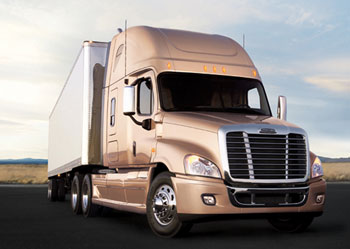
When it comes to emissions standards, always try to buy the latest and greatest, Simons advises. This will give the secondary buyer, whether domestic or foreign, the possibility of using that vehicle longer as allowable emissions face greater restrictions in the future.
What to avoid? Simons says stay away from unusual cab colors. Red, white, blue, silver and black––with black frame rails––offer the best resale value. Also fleets may want to consider aluminum wheels, which are a plus for both appearance and weight savings. Simons also encourages first-owners to spec’ air-slide fifth wheels.Fleets are keeping equipment longer than ever, so long-life, quality components that will last for the second owner also increase resale value. One example is copper instead of aluminum heater cores in HVAC systems, Simons adds.
Transmission speed
According to Brock Frederick, manager of pricing and assets, International Used Truck Organization, when fleets choose truck and engine specifications, many options and spec’s figure into the decision. A 13-speed transmission will deliver additional resale value over the 10-speed (an 18-speed will retain the highest resale value for an owner-operator truck). When having identically spec’d trucks with the only difference being overdrive or direct transmission, most customers will choose the overdrive, Frederick says.
Other spec’s to consider will affect weight, driver retention, and overall performance. For example, 10 aluminum wheels versus six aluminum and four steel with a premium-level interior rather than a base-level package will add residual value. An air-slide fifth-wheel compared to a stationary fifth-wheel will also add value. Other options to consider spec’ing to increase resale value are an upper bunk, chrome packages and full aero packages (including skirts). n addition, the company adds that a MaxxForce engine provides weight savings, fuel economy and life expectancy against other 15-L engines, which can result in a higher resale value.
Cost of ownership
Smart fleet truck buyers know it’s important to consider resale value when purchasing a new tractor. “It’s the way you ultimately tally the cost of ownership,” says Andy Zehnder, Kenworth’s on-highway product manager. “To maximize resale value, you should keep an eye on the future ––what are the trends in spec’ing and how will they change? But, you need to be able to use those spec’s today, too. It’s sometimes a balancing act.” 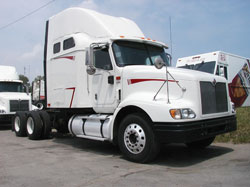
Zehnder, who says that fleet managers should consider tractor aerodynamics, notes, “Fuel prices aren’t likely to go down, so look at all the fuel-saving enhancements and truck models that can get you EPA SmartWay certified. Not only will you save fuel now, but as SmartWay becomes more entrenched, and businesses insist on certification in order to haul for them, your truck will be more in demand.”
He also says to look at components such as high intensity discharge headlamps that last up to 11 times longer than sealed-beam lamps. Or consider the impact of future vehicle compliance issues, like the FMVSS 121 stopping distance mandate that goes into effect August 2011,on the truck’s spec’. Zehnder suggest that fleets that spec’ air disc brakes or larger brake drums will not only have a superior braking system, but also be in position to meet those future stopping distances, and the truck will stand out against trucks with standard braking systems.
Big sleepers with premium interiors are one of the biggest paybacks, says Zehnder. He suggests that there is more value for a bigger sleeper and premium interior, because the price difference upfront is typically regained at resale. If you buy a enworth day cab, look into spec’ing the Extended Day Cab, which he notes, gives you more leg room and room behind the steering wheel, plus added storage.
Aerodynamic packages
When buying for resale, David Giroux, director of marketing communications for Peterbilt Motors Co., says, “Peterbilt’s new packages designed to improve fuel efficiency are an ideal way for fleets to maximize resale. These new aerodynamic-styled models appeal to fleets and owner-operators who desire fuel efficiency, driver comfort and high resale value.”
Peterbilt has introduced an aerodynamic package for its on-highway Models 386 and 384 that improves fuel economy to provide up to an estimated 12% fuel savings. The package was designed to reduce vehicle drag by up to 24%, resulting in an estimated $5,600 in savings annually (130,000 miles, at $2.30/gal.) versus a comparable non-equipped Peterbilt Model 386 or 384. 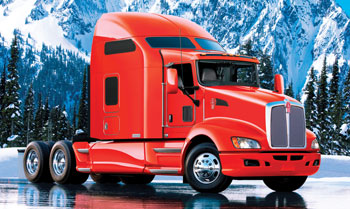
“Through extensive aerodynamic evaluation, Peterbilt engineers have designed a proprietary package to optimize the company’s most aerodynamic Models 386 and 384,” says Landon Sproull, Peterbilt chief engineer. “Proper truck specification is critical in maximizing fuel efficiency, Peterbilt’s new aerodynamic package provides the optimum set of components specially designed to increase fuel efficiency and add savings to our customers’ bottom line.”
In addition to the package for the Aero models, a new proprietary fuel efficiency package for traditional models was designed to provide fuel savings gains of up to 12% for Models 388 and 389. According to Peterbilt, the package’s set of proprietary components reduce vehicle drag by up to 24%, resulting in an estimated $5,600 in savings annually (130,000 miles at $2.30/gal.) versus a comparable non-equipped Peterbilt Model 388 or 389.
Aerodynamics also play an important part in making a truck appealing at the time of resale. Peterbilt offers:
• Proprietary roof fairings with trim tabs to help push air up and over the cab and trailer to reduce drag and improve fuel economy.
• New sleeper roof transition with a design that provides a smooth transition between the cab and sleeper rooflines.
• Enhanced chassis fairings re-contoured at the end to feature a “flair” design element, which redirects airflow around the rear tires and wheels.
• Aero battery box/toolbox that is optimized to provide better airflow under the cab for improved aerodynamics.
• Composite sunvisor with less aerodynamic drag that maximizes glare protection.
• Sleeper extender that features a 3-in. rubber extender flair to redirect airflow outward and around the trailer.
• Aerodynamic mirrors that include a tough, lightweight, four-way adjustability providing both vertical and horizontal adjustments, an integral convex mirror and fully heated primary and convex mirrors.
Order for your fleet
Jerry Warmkessel, marketing product manager, Highway Products, Mack Trucks Inc., says that the primary objective is to order the truck for the original owner’s application. Be certain you are not so concerned about resale that you spec’ the truck in a manner that it is not efficient for your operation. This could lose you any gain you may pick up at resale.
He continues, “Stay with industry-standard components as much as you can. These components can generally be repaired at almost any Class 8 OEM dealer or independent repair shop. Spec’ ‘middle of the road’ horsepower unless your operation requires high horsepower for a particular application. Today, most customers are looking for trucks that will get their job done while using the least amount of fuel. Most of the Class 8 diesel engines today can have their horsepower adjusted up or down with software only. Today’s owners and drivers are realizing that having 600-plus HP under the hood is no longer a status symbol, but rather the sign of an uneducated operator.” 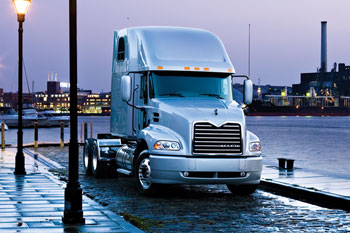
Warmkessel also says fleets should try to spec’ a generic paint color. Special colors or color schemes that define your fleet will typically be a deterrent to the second owner. Solid white or red typically fits in with any fleet without requiring a repaint. Today a repaint can cost upwards of $3,000––even more with a sleeper unit.
In addition, Warmkessel says that the wheelbase is very important. Spec’ a little longer rather than shorter if possible. Many operations require special frame-mounted equipment, and having to stretch a frame can be a costly procedure. Other than a few additional pounds, a longer wheelbase has little negative affect on a typical tractor operation with a sliding fifth wheel.
With today’s focus on fuel economy, a lighter-weight truck will typically use less fuel while providing the opportunity for additional payload. Be certain, however, durability is not compromised for the original owner just to ensure better resale value. In addition, spec’ maintenance-free components where possible. “Today’s truckers are sensitive to downtime for maintenance, and the more time on the road, the greater opportunity for profit,” says Warmkessel. “While typically maintenance-free components cost a bit more up front, they certainly pay dividends in the long run.”
He suggests that if the truck has a sleeper berth, spec’ a mid-size bunk with stand-up capability. Today’s operators that spend overnight time in the truck want the ability to stand up as well as having ample storage. Mack’s 60-in. and 70-in. midrise are by far the company’s most popular sleepers. Also, spec’ shore power and inverters to let drivers plug into standard duplex receptacles when using typical home appliances such as
microwave ovens and TVs.
Horsepower and appearance
Michael McColgan, director of used trucks for Volvo Trucks North America, says that among the most-desired features on used trucks are 450- to 550 HP engines and the ability to run at highway speeds in the sweet spot of the fuel curve (68- to 70 MPH). Certain engines, such as the Volvo D13, can be ordered at 435 HP and uprated to 485 HP for resale, affording the original owner lower horsepower for the desired application while providing resale value later. He adds to always spec’ transmissions, drivelines and other components that match the maximum horsepower and torque uprating potential.
Also desired in used trucks is an attractive physical appearance. Polished aluminum wheels not only lower vehicle weight and take away brake heat more quickly than steel wheels, McColgan says, but their bright finish appeals to a pre-owned truck buyer. Bright bumpers similarly enhance a tractor’s appearance. 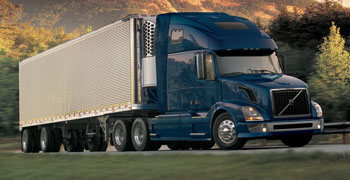
At minimum, McColgan recommends spec’ing a mid- to upper-level interior. “Every driver has a level of pride, and having something that is not the bare minimum boosts the driver’s ego, and that has a positive influence on the driver’s desire to care for that piece of equipment for the original owner while increasing resale value.” Customers for pre-owned trucks are buying on emotion as well as need, he adds, so even small details can make a difference. Attention to creature comforts is going to enhance the vehicle’s resale value. An upper-level interior may bring as much as $3,000 more at resale.
With the ongoing implementation of ever-more stringent CARB rules for operating older trucks in California––and potentially in 13 more states that may soon adopt CARB rules––McColgan has seen an increase in demand for EPA ’07-compliant vehicles with built-in DPF technology that buyers know they’ll be able to run for years to come without the need to retrofit emissions control devices. FE


